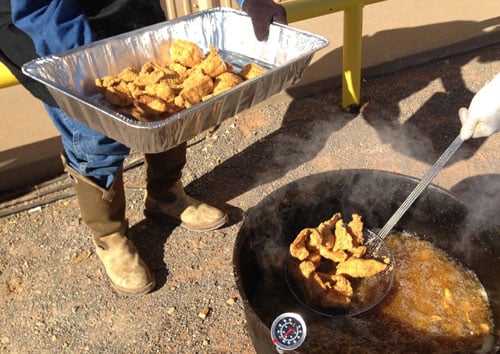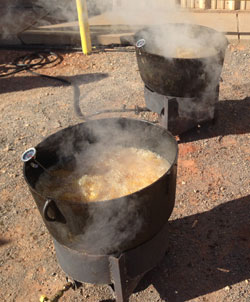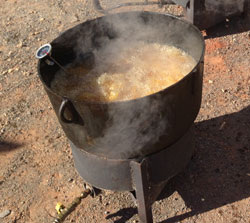
Imagine the warm breeze, the sound of crackling oil, and the tantalizing aroma of freshly fried catfish wafting through the air. There’s something truly special about the Southern tradition of indulging in perfectly crispy, golden-brown fried catfish. As an outdoor cooking enthusiast, I’ve had the pleasure of mastering the art of frying catfish, and in this article, I’ll share my knowledge and suggestions to help you create mouthwatering fried catfish right in your own backyard. Keep Reading to see how we fry catfish from the south!
The Southern Tradition of Fried Catfish
Fried catfish holds a prominent place in Southern cuisine, deeply rooted in tradition and cultural heritage. From family gatherings to community fish fries, this beloved dish brings people together and leaves a lasting impression. Its popularity is attributed to the unique combination of flavors, textures, and the joy it brings to the table.
Choosing the Right Catfish
To achieve the best results, it’s crucial to select the right type of catfish. Opt for fresh catfish fillets that are firm, moist, and free from any unpleasant odors. Channel catfish and blue catfish are popular choices due to their mild flavor and firm texture, perfect for frying. Ensure that the catfish is sourced responsibly and sustainably to support local communities and preserve aquatic ecosystems.
Preparing the Catfish for Frying
Before diving into the frying process, proper preparation of the catfish is essential. Start by rinsing the fillets under cold water to remove any excess slime. Pat them dry using paper towels, which helps the breading adhere better. Trim off any visible fat or dark portions for a cleaner taste. Season the catfish with a sprinkle of salt and freshly ground black pepper to enhance its natural flavors.
Breading and Seasoning Techniques from the South
The breading plays a crucial role in achieving that irresistible crispy exterior while keeping the fish tender and juicy on the inside. The classic method involves a three-step process: dredging in seasoned flour, dipping in an egg wash, and then coating with a final layer of breadcrumbs or cornmeal. This creates a delightful crunch and adds layers of flavor. For an extra kick, experiment with various seasonings like paprika, cayenne pepper, garlic powder, or herbs like thyme and parsley.
Selecting the Perfect Cooking Equipment
To get the best results, invest in a deep-fryer or a large cast-iron skillet for outdoor cooking. These provide consistent heat distribution and maintain the desired frying temperature. Alternatively, a sturdy Dutch oven or a heavy-bottomed pot can work just as well. Ensure that the cooking vessel is deep enough to submerge the catfish fully without overcrowding, as this promotes even frying and prevents oil temperature fluctuations.
Outdoor Cooking Tips
When it comes to outdoor cooking, there are a few tips and tricks that can elevate your fried catfish game. First, make sure you have a well-ventilated outdoor cookingarea to prevent excessive smoke buildup. Additionally, keep a fire extinguisher nearby for safety purposes. Consider using a high smoke point oil such as vegetable oil, peanut oil, or canola oil for frying. These oils can withstand the high temperatures required for frying without imparting unwanted flavors. Preheat the oil to around 350°F (175°C) to achieve that perfect crispy texture.
Timing and Temperature Considerations
Timing is crucial when frying catfish. Overcooking can result in dry and rubbery fish, while undercooking can leave it raw in the center. Aim for a cooking time of about 4 to 6 minutes per side, depending on the thickness of the fillets. Use a kitchen thermometer to ensure the internal temperature reaches at least 145°F (63°C) for safe consumption. Remember to let the fried catfish rest on a wire rack or paper towels for a few minutes after frying to allow excess oil to drain.
Presentation and Serving Suggestions
Presenting your fried catfish in an appealing and enticing manner adds to the overall dining experience. Arrange the golden-brown fillets on a platter lined with fresh lettuce or garnish with lemon wedges for a pop of color. Serve with traditional Southern sides such as coleslaw, hush puppies, and tartar sauce. For a lighter option, accompany your catfish with a mixed green salad or roasted vegetables. Don’t forget to provide hot sauce or remoulade sauce on the side for those who enjoy a bit of heat.
Healthier Alternatives to Traditional Fried Catfish
While traditional fried catfish is undeniably delicious, it’s worth exploring healthier alternatives that still deliver on flavor. Consider oven-baked or grilled catfish options. Oven baking provides a crispy exterior without the need for excessive oil, while grilling imparts a smoky flavor and adds a delightful char. Experiment with marinades and rubs to enhance the taste profile further. These cooking methods reduce the calorie and fat content while maintaining the catfish’s natural succulence.
Exploring Regional Variations
Catfish holds a special place in the hearts of many regions, each with its own unique spin on the dish. Take the opportunity to explore regional variations and expand your culinary horizons. Whether it’s Cajun-spiced catfish from Louisiana, cornmeal-crusted catfish from the Midwest, or the soul food classic from the Deep South, each variation brings its own flair and cultural significance.
Sharing Stories and Memories
Fried catfish is not only about the food; it’s about the memories and stories shared around the table. It’s a dish that sparks conversations, laughter, and bonding among friends and family. Take the time to create your own traditions and make lasting memories while indulging in this Southern delicacy. Share your experiences with others, exchange recipes, and celebrate the joy that comes with sharing good food and good company.
Conclusion
Fried catfish from the South is more than just a meal; it’s an experience. The combination of flavors, the crispy texture, and the rich cultural heritage make it a dish worth mastering. With the right catfish, proper preparation, and the right techniques, you can create a mouthwatering feast that will impress your guests and leave them craving more. Whether you choose the traditional fried version or opt for healthier alternatives, the joy of outdoor cooking and the pleasure of savoring this iconic dish are truly unmatched.
Fried Catfish from the South FAQs
1. Can I use frozen catfish fillets for frying?
While fresh catfish is recommended for the best flavor and texture, you can use frozen fillets as well. Make sure to thaw them thoroughly before preparing and frying.
2. What are some alternative coatings for breading the catfish?
If you’re looking to experiment with different coatings, there are several options you can try. Instead of traditional breadcrumbs or cornmeal, you can use crushed crackers, panko breadcrumbs, or even crushed potato chips for a unique twist. These alternatives can add different textures and flavors to your fried catfish.
3. Can I fry catfish indoors if I don’t have outdoor cooking equipment?
Absolutely! While outdoor cooking adds a certain charm, you can still achieve delicious fried catfish indoors. Use a deep, heavy-bottomed skillet or a deep-fryer on your stovetop. Make sure to maintain proper ventilation and be cautious of oil splatters. Follow the same steps and techniques mentioned earlier for a tasty indoor cooking experience.
4. How do I know when the catfish is cooked perfectly?
The best way to determine if the catfish is cooked perfectly is by using a kitchen thermometer. Insert it into the thickest part of the fillet and ensure it reads at least 145°F (63°C). This guarantees that the fish is cooked through and safe to eat. Additionally, you can check the color and texture of the fish. The catfish should be opaque and flake easily with a fork.
5. Can I use other types of fish for frying instead of catfish?
Certainly! While catfish is a popular choice for frying, you can experiment with other types of fish as well. Tilapia, trout, cod, or even halibut can be used for delicious fried fish dishes. Adjust the cooking time and techniques accordingly based on the specific fish you choose.
Remember, the key to achieving the best results is practice and a willingness to experiment. Enjoy the process of outdoor cooking and let your creativity shine as you master the art of frying catfish from the South.
Fried catfish from the Southern is a tradition, along with hush puppies and coleslaw. Try these traditional foods together.
Catfish are a diverse group of ray-finned fish without scales. They are named for their prominent barbels, which resemble a cat’s whiskers.
Catfish range enormously in size and behavior. From the big Mekong giant to the tiny parasitic species commonly called the candiru.
Catfish are of considerable commercial importance; many of the larger species are farmed or fished for food. Many of the smaller species, particularly the genus Corydoras, are important to aquarium hobbyists.
Catfish can have a very muddy flavor. That’s the reason I advise you to buy only farm raised.
Fried Catfish from the South For Large Groups
Catfish is a great success if you are serving a large number of people like you see on the images. Take 10 ounce per person for big eaters. Slice your fish into thin pieces of 2 ounce.
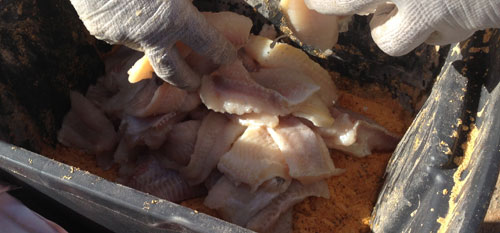
Breading Your Catfish
I know that most people like there fish in beer batter but traditional catfish belongs in cornmeal. If you want to go all the way then use fine, white cornmeal if you can find it. In the absence of fine, white cornmeal, use regular cornmeal with a little flour. Unless it is finely ground, an all-cornmeal crust tastes rather gritty.
Prepare your cornmeal with salt and cayenne pepper and roll your fish in it until fully covered.
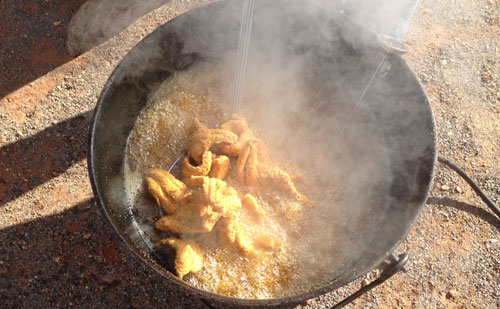
Frying your catfish
Use a strong gas burner and a really big pan. If you do this in your home you just have to fry smaller portions at a time. You want the fish to have lots of space in the fat so that you do not damage the crust.
TIP: Did you know that if you use seed oils for frying they will not transfer the fish flavor to another dish? You pay a little more but your oil can go a longer way before you have to replace it.
Heat your oil to 350° Fahrenheit and keep it there. Use a good food thermometer to keep an eye on your hot oil. Fry your catfish for about 7 minutes until crispy and cooked. If you need to, you can keep it warm in an oven at 150° Do not cover with foil.
Tip: If your oil ever catches on fire, then do not try to extinguish it with water. You will cause an explosion. If possible put a lid on the pan to stop the oxygen from feeding the fire. If you have powder extinguisher you can use it. To avoid problems fry outside and never leave your oil unattended.
If you have no extiquisher on hand and no lid then use flour to smother the flames.

